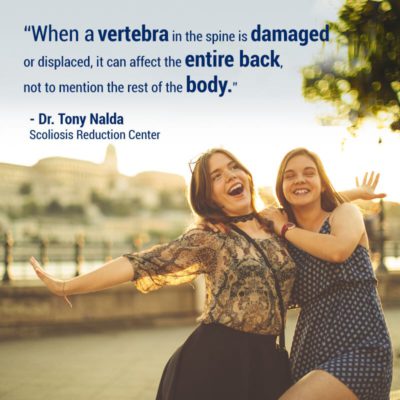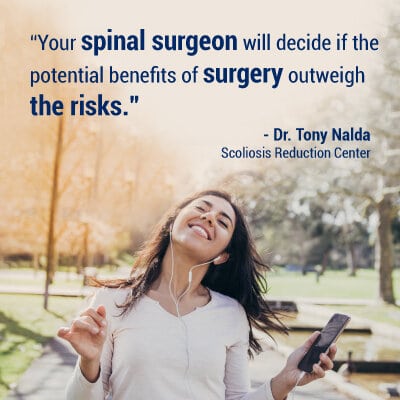As the spine affects virtually every system within the body, spinal surgery is considered invasive and can carry significant risks and recovery time. Many doctors view spinal surgery as a last resort after less-invasive spondylolisthesis treatment options have already been explored.
Understanding Spondylolisthesis

The spine consists of numerous small bones called vertebrae. When a vertebra in the spine is damaged or displaced, it can affect the entire back, not to mention the rest of the body.
In the event a vertebra slips out of place, it is no longer in alignment with the rest of the spine, and this condition is called spondylolisthesis. While most common in the lower spine (lumbar), it can also occur higher up in the spine.
Causes of Spondylolisthesis
Misalignment of the spine due to spondylolisthesis can be caused by a number of reasons. Some people are born with defects that cause the condition, while others develop it as a result of a traumatic blow to the spine. Tumours can also damage a vertebra or cause it to slip out of alignment. Spinal degeneration due to aging is another common cause.
Symptoms of Spondylolisthesis
While some people can live out their entire lives without even being aware they have spondylolisthesis, others can experience one or more symptoms associated with the condition. As is the case with most medical conditions, symptoms and their severity tend to increase with age.
It’s also not uncommon for individuals to discover they have the condition while they are being examined or undergoing X-rays for another reason. While every case is different and symptoms vary with severity and age, the most common symptoms include:
- Bain pain
- Stiffness in the back
- Difficulty with walking or running
- Sciatica issues such as pain in the legs and/or buttocks
- An abnormal curvature of the spine
The Connection Between Spondylolisthesis and Scoliosis
With spondylolisthesis, one of the potential symptoms is an abnormal spinal curvature that develops as a result of the spine’s misalignment. Characterized by a sideways curvature of the spine, scoliosis can develop from spondylolisthesis. Characterized by a forward curvature of the spine, hyperkyphosis can also develop. Lordosis, an inward curvature of the spine, is also a possibility.
In addition to the visual asymmetrical effects that a spinal curvature can produce – uneven shoulders, rib hump, prominent rib cage, postural changes – scoliosis, hyperkyphosis, and lordosis can affect self-esteem and cause body-image issues, especially in adolescents.
Scoliosis, hyperkyphosis, and lordosis themselves can also lead to a number of additional health issues in severe cases or if left untreated:
- Back pain
- Decreased levels of flexibility and mobility
- Decreased lung function
- Digestive issues
- An asymmetrical appearance to the body
- Impairment of bladder and bowel function
Treatment Options for Spondylolisthesis
As every spondylolisthesis case is different, each patient will have to work with their doctor to explore potential treatment options that address the cause, symptoms, and condition severity of their individual condition.
Once a diagnosis of spondylolisthesis is given, potential treatment options can begin. For milder cases, lifestyle changes can make a big difference.
Lifestyle Changes
Increasing exercise that encourages flexibility and strengthens the back muscles can be very beneficial in terms of managing the condition and any related pain and discomfort. Spondylolisthesis-specific physical therapy programs would target aspects of the condition as an effective and proactive means of strengthening the back and better enabling the body to live with and manage the condition.
Weight loss is a common recommendation for people dealing with conditions like spondylolisthesis. If obesity is an issue, diet and exercise recommendations can be an integral part of a treatment plan. Not only is it easier to fully access and monitor a patient’s spinal deformity if there is no excessive weight, people who are overweight are generally less healthy and are less likely to experience treatment success than someone who is fit and active.
Pain Management and Physical Therapy
If pain is an issue, in addition to taking over-the-counter pain medications, your doctor can prescribe stronger medications or anti-inflammatory medications if needed.
Physical therapy is another common treatment option for managing pain related to a number of spinal deformities. Physical therapy can help a person build up the core muscles in their body and back’s midsection through strength training; this can help support the spine and better enable it to handle the challenges and pain associated with spondylolisthesis and other conditions that affect the spine.
Physical therapy recommendations often include a number of stretches known to extend the spine and reduce muscle tightness; done safely, this is an effective way to improve flexibility and relieve pain naturally.
Spinal Surgery
Most often, surgery is only recommended for extreme cases. Spinal surgery is invasive, expensive, risky, and can cause significant side effects.
Cases that are most likely to require surgery are those where there is significant spinal damage, the vertebra is still slipping, or where other pain-management strategies have failed.
The ultimate goal of spinal surgery is to return the spine to a normal alignment, or as close as possible, remove pressure from the spinal nerves (decompression), and to stabilize the spine. A spinal surgeon can remove excessive bones, replace missing vertebra, or fuse the vertebrae back together.
While some patients with spondylolisthesis might view surgery as the most effective way to remedy a spinal deformity, many of those patients can manage their condition safely with a combination of medication and therapies.
Different Types of Spondylolisthesis Surgeries for Different Causes
While most surgeons agree that decompressing the nerves is beneficial, when it comes to whether or not a slipped vertebra should be realigned is another matter. Most often, the decision to realign, or not to realign, depends on the cause and severity of the condition.
Traumatic Spondylolisthesis
With cases of traumatic spondylolisthesis, realignment via surgery is a fairly simple procedure. As the spine hasn’t adapted to the slip by readjusting over time, not as many structures of the spine have been affected, making it simpler to fix. For other types of spondylolisthesis, however, spinal surgery is often a last resort.
Congenital Spondylolisthesis
With congenital spondylolisthesis, the condition is present at birth. It terms of correction, that means the rest of the spine has had lots of time to compensate and adjust on its own to the deformity; in those cases, trying to fix it with surgery can be too complex, can involve too many spinal structures, and can end up leading to additional problems.
Degenerative Spondylolisthesis
Spondylolisthesis caused by degeneration can benefit from decompression, and while fusion is sometimes necessary, realigning the slippage can be risky. The longer a patient has been living with degenerative spondylolisthesis, the more challenging suddenly restoring alignment can be. There is a risk of bone fractures, nerve injury, and there is an increased risk of instrumentation failure.

In most cases, nonsurgical approaches to manage pain are attempted for significant lengths of time before surgery is considered. Your spinal surgeon will decide if the potential benefits of surgery outweigh the risks, and that will depend largely on what caused your condition to develop.
Reasons a Doctor Won’t Perform Surgery for Spondylolisthesis
Even the most minor surgeries carry risks; spinal surgery carries some pretty extreme ones. Unless a case is severe enough to necessitate surgery, a combination of different treatment options should be explored first.
If you haven’t tried some alternative treatment options before looking into surgery, many doctors would refuse to perform an invasive procedure such as spinal surgery. A doctor will also refuse to perform surgery if it is not an appropriate treatment option for the type of condition you have, or if the benefits simply don’t outweigh the risks.
In the event that a condition is extremely severe, is worsening, or pain is unmanageable, surgery can be a last resort, but it still comes with a long list of potential side effects and complications:
- Hardware failure
- Adjacent segment degeneration
- Bleeding
- Infection
- Dural leak
- Nerve root damage
- Anesthetic risks such as blood clots, pneumonia, heart attack or stroke, and pulmonary emboli
In addition to the above reasons for a surgeon not wanting to perform spinal surgery, age is another big one. If a patient is simply too old to withstand the rigors of surgery and recovery, or if the bones or spine is too weak due to the degenerative effects of aging or bone-density issues, these are instances where a doctor will refuse to do surgery. In these cases, there is little that can be done, other than pain management. On the flip side of that, if a patient is too young and has not yet stopped growing, this is another potential reason for a doctor to refuse performing spinal surgery.
Conclusion
Surgeons have their patient’s best interests at heart. If they feel a patient’s spondylolisthesis is better managed by a less-invasive treatment plan, those options should be thoroughly explored first.
In many cases of spondylolisthesis, individuals can live quite comfortably with the condition for their entire lives, and let’s not forget the number of people who are unaware they even have the condition. The fact that it’s often discovered accidentally during medical exams or X-rays indicates there’s a substantial number of people living with the condition with minimal or no symptoms.
For patients who develop spinal curvatures or other complications related to their spondylolisthesis, there are numerous treatment options, other than surgery, to explore. That is why, here at the Scoliosis Reduction Center®, every treatment plan is customized to each individual patient and their condition.
When physical therapy programs are condition-specific, they can be extremely effective in terms of correction, restoring function, relieving pain, and increasing strength and flexibility. Making positive lifestyle changes can also have dramatic results in terms of living with and managing a condition like spondylolisthesis. In many spondylolisthesis cases, spinal surgery is not only unnecessary, it can also cause additional complications, and that’s the main reason a surgeon wouldn’t want to perform spinal surgery.





